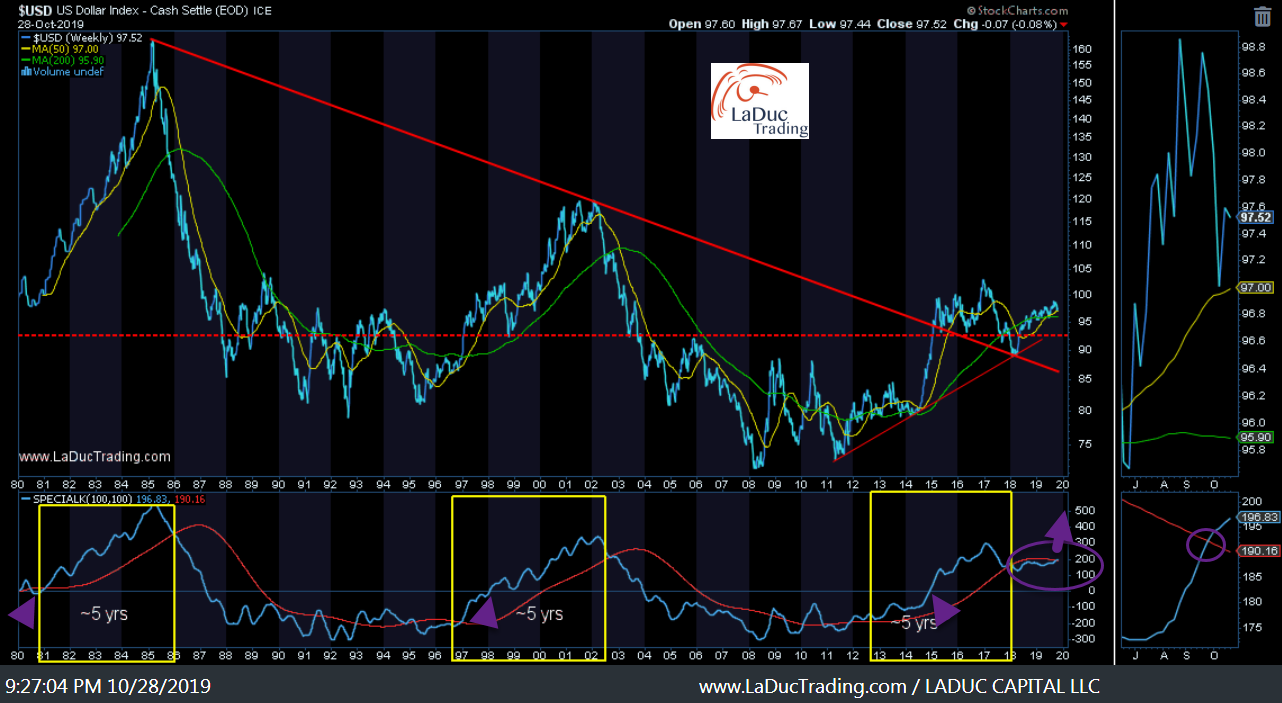That Was Predictable
- 84 FOMC meetings since expansion began…
- 72 meetings: mkt priced in no rate change & no change.
- 9 meetings: mkt priced in 25 bps hike & Fed hiked 25 bps.
- July, September, & Today: mkt priced in 25 bps cut & Fed cut 25 bps.
- Not one surprise.
@charliebilello
I have written about this phenomenon before for clients; that we have a 100% success rate of market getting what it predicts from the Fed. But there’s always the first time, so we all cozy up to our electronics and I open my live trading room just in case.
So wherein it is much easier to trust the market’s predictive powers, the Fed’s own Forward Guidance leaves much to be desired. A reminder, the FOMC’s summary of economic projections (SEP 2018) showed a consensus forecast (100% of members) calling for no rate cuts in 2019. This is the third time in just one year they have gone against their forward guidance. So why should we believe them when they tell us they can protect us from a Liquidity Panic?
Why’d They Do It?
Fed cut 1/4 point, as expected. Many are still wondering why as tensions seemed to have eased (or at least pushed out in time) on both Brexit and US-China trade negotiations. Yes, October saw manufacturing and services data miss, with lower retail sales and durable goods orders, but this is not enough. Powell seems to intonate that an ounce of prevention is worth a pound of cure. For the cynical, a precautionary measure equates to a coming crisis.
Top 15 Market Risks I Can Think Of Off The Top Of My Head
- Global Economic Slowdown
- Fed Rate Cutting Cycle
- Trade War Escalation Uncertainty
- Tariff Earnings Impact
- China Deleveraging/Currency Manipulation
- Brexit
- Impeachment
- Record Debt/Deficits
- Negative Interest Rates
- Repo Madness/Cash Hoarding
- Private Equity/Valuations
- Unfunded Pension Liabilities
- WorldWide Riots/Income Inequality
- 2020 Election/Dem POTUS/Risk to Stock Buybacks
- Liquidity Concerns
Market ‘Should’ Rally
Powell announces the expected Fed cut, waxes hawkish, and then collars the Fed statement which is in essence a collar on the market.
What do I mean? Fed cuts interest rates when equities are at all time highs and US has better economic data than rest of world. The US stock market stays levitating near all-time-highs where it has been for the better part of two years. It’s a version of the famous “Fed Put”, which is supposed to be used only in emergencies.
Curious types will recall how we got here. We went from September 2018 with consensus that we would see no rate cuts for 2019 to cutting 3 times in a little over a year’s time. The 1st cut was supposedly to soften the impact from Trade War Tariffs. The 2nd cut supposedly to mitigate the rising recession risk as expressed through the inverted Treasury yield curve. But this time? Why cut a 3rd time? Avert potential funding freeze in the Repo Market? It still remains to be seen if Fed believes we have a lurking crisis, but we just don’t see it yet.
Clearly the bond market is not convinced with Powell’s assessment of the stability in the economy in general and Repo market in particular. Yields continued south Friday and interest rate expectations for future cuts soared. And as I mentioned above, the market always gets what it wants.
“Easing is the path to the dark side… Easing leads to dependence. Dependence leads to addiction. And addiction leads to suffering.” Yoda
I have made the point since June that the Fed would need to cut rates significantly to eliminate the rate differential or “spread” between domestic fed funds and the effective negative cost of funds offshore. Their liquidity injections aren’t enough.
The Federal Open Market Committee is essentially trapped in the torment of Sisyphus. They keep trying to add liquidity to the domestic US money markets, only to see it leak out into the vast offshore market for dollar funding. Christopher Whalen
At the onset of the Press Conference Powell implied that Fed was satisfied with its Monetary Policy. (Oh, how that line is going to haunt him someday.) This is when he signaled a Hawkish Hold with Dovish Intention. Powell implied Fed was done with rate cuts for the year, but would cut again in the future if data dictated, so “Three and Done” mid-cycle adjustment rate cut cycle was not the swan song it could have been. Essentially, Fed is flying low to the ground but not sure where to land.
When Inflation Takes Flight. What Inflation?
When Powell said Fed saw no further rate hikes until signs of inflation appear, dollar reversed lower hard. We already have opaque interpretation of the ‘Data’ by which the Fed determines rate hikes and cuts, but understand we have all kinds of Inflation just not the kind the Fed measures. But as long as this Fed-speak is populated that we have no inflation, then rates can stay low. They can even go lower and likely will.
No Inflation Anywhere in the Developed World
Jim Bianco makes a good point: Central Banks Can’t Create Negative Rates by Themselves
- Technology squashes core inflation
- Older people are buying bonds thus driving yields lower
- The world savings glut is leading to massive bond buying that is resulting in yields dropping
- Global flight-to-quality will likely continue as the world economy slows
- Financial repression from central banks will continue as they take monetary policy rates into negative territory
With disinflation not inflation present, it would appear Fed is more likely to cut than raise – unless they fail to control liquidity (through repo funding), treasury supply (from financing deficit spending) and the US Dollar from spiking higher (which QE deflates). The Central Banker To The World has said they will not raise rates until they see inflation. Just like in 2018 they gave forward guidance they would not cut rates in 2019.
The Higher Rate Thesis
America’s fiscal policy will drive interest rates up. Wait, what? How can rates rise when the Fed is cutting and the market is demanding they cut?
There is a potential for rates to rise in response to the Fed having to “print money” to buy Treasury securities in order to prevent short-term rates from going up. The Treasury is issuing government debt as fast as it can in order to pay for the current massive deficits (well over $1 trillion this year), and because the market doesn’t want to swallow all that debt at the rate the Fed has set (China, e.g., is out of the market). U.S. government cannot issue more debt without driving up interest rates – it is simply a question of supply and demand, according to Martin Lowy.
So that’s the rub. The market can force interest rates on Treasury securities up because fiscal policy is not in alignment with monetary policy.
Higher Dollar, Lower Stocks Thesis
Another debate currently raging is between those who are Bullish the US Dollar and those who feel it is very much about to crash sending precious metals like Gold and Silver significantly higher. To that, I have several Macro-to-Micro reasons to remain bullish:
- Our Interest Rate Yield Differential with rest of world will continue to attract foreign issuance of US Dollar debt
- Exploding US Dollar deficits require financing from our Treasury which drives supply which in turn drives up interest rates
- US Dollar shortage from foreign issuance, Treasury supply and cash hoarded around the world (especially in US Banks) is not slowing
For technicians, here’s my favorite chart on the US dollar. It has been consolidating for 4 years and above all the important indicators it needs to stay above in order to stay bullish.

Large American companies can go abroad to finance debt at lower (to negative) rates than smaller US-focused companies, buyback their shares and participate in their stock prices rocketing higher. As a result, 20% of negative yielding Corporate Bonds are American multi-nationals that issued debt with negative yields according to Jim Bianco @biancoresearch
The playbook has been simple: Accumulate $4T in corporate debt issuance to fund $4T of equity buybacks. The result: a runaway bull market. So what could truly change this seemingly unstoppable rate of ascent in share prices?
- Slowing earnings – in progress
- Higher interest rates – not yet
- Higher US dollar – still in play
- Policy change – think: 2020 election
- Liquidity crisis – cash hoarding is already happening in repo markets
Slower earnings, say, from a US-China Trade War to a large extent, Brexit from a smaller one, can slow the growth rate of earnings which can lower the correlated debt issuance to fund stock buybacks. That’s occurring now as Q3 is expected to have a -3% earnings growth.
Higher interest rates from Treasury supply financing deficits is a thesis that has not kicked in but is a risk to consider, especially as it relates to liquidity of those markets. Should rates spike, corporate debt servicing will be made more expensive, and some could not survive it.
Higher US dollar is defacto tightening and has been in play since 2014, but especially felt after repatriation of overseas cash post tax cuts early 2018 when Trump’s Trade War kicked off. In fact, as interest rates were dropping over the past year, the USD grinded higher. It has only paused of late on talks of a Trade Truce. Should a trade deal of any substance not materialize and/or a recession triggers instead, the safety trade into dollars will further spike prices.
But the biggest of all impacts to the continuation of stock buybacks would be a change in policy as a direct result from a change in political leadership that aims to limit or ban stock buybacks all together. And both the front-runners of the Democratic party, Warren and Sanders, say they would ban stock buybacks almost immediately.
And the biggest impact to the continuation of the 10 year Bull Run is a Liquidity Crisis, and there is the potential for bonds to sell off, rates spike, dollar break out all while Trump is under Impeachment investigation and the Democratic ticket for 2020 promises a change in the fundamental reason for the stock market’s advance: stock buybacks.
Market Correction Predicted
I have suggested for months that I suspect a Turn after 10/31 – around SPX $3060 and NYSE $13,333 – and that this would trigger a reversal with lower prices starting in mid-November through end of the year. But in the prediction and investment game, we can be right but have the timing wrong.
I continue to look to bonds and gold, the hallmark trades of this year’s Central Bank-driven rate reversal, and note how they have yet to make new highs despite a slew of bad global and U.S. data, high likelihood of Trade Deal falling apart, and rate-cut expectations from here to NIRP (negative interest rate policy).
The global carry trade, otherwise known as the Bond Bull Market of 2019, is a case where there are simply too many bonds being chased in the financial system and not enough cash on the other side of the trade. When this reverses, panic can ensue. And a true liquidity crisis creates panic – where everything sells off, even Gold and Bitcoin. Only those who are sitting on the sidelines will be in a position to pick up shares on the cheap.
I also don’t think shorting will be a six month ride down the hill like in 2008. A liquidity freeze is one thing, but a panic for cash, can morph into a liquidity Flash Crash event and convulse lower over weeks not months. Risk premiums will be so quickly elevated in this race for liquidity and in this time of Quant Funds and Algos that even those who try to short let alone protect in the thick of this downdraft will be played by Market Makers.
I see the asymmetrical rewards of playing this game of trading to benefit those who are either positioned short soon or have the patience to wait for the reset, which could be about 30% lower. Given current valuation for S&P near 20X income and Nasdaq near 24.5X, a reset lower in PE ratios would also incentivize some of the mass quantities of cash on the sidelines to come back into the market. Until then, there is very little reason to expect a break-out and more likely a break-down – despite the Fed’s most dovish intentions. They still won’t save the markets from a Liquidity Panic for Cash.

